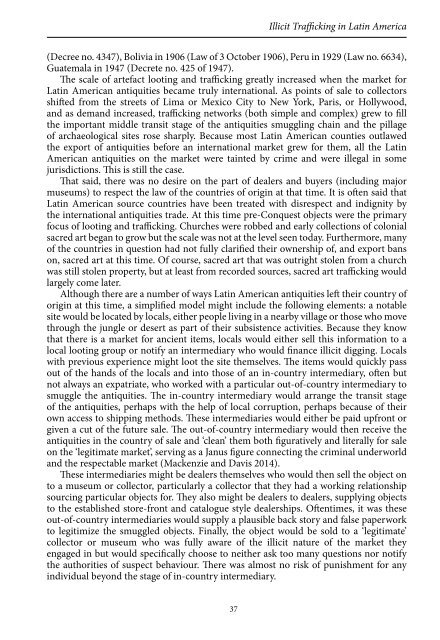Countering
Book_observatory_illicit_traffic_version%20issuu
Book_observatory_illicit_traffic_version%20issuu
Create successful ePaper yourself
Turn your PDF publications into a flip-book with our unique Google optimized e-Paper software.
Donna Yates<br />
The following case study illustrates an extreme version of this model which, due to its<br />
relatively late date, was fully exposed. This represents a rare example of traffickers being<br />
caught and brought to justice and there is every reason to think that previous networked<br />
trafficking incidents from Latin America were much like this one, only with a lot less<br />
hesitation on the part of buyers.<br />
Network case study: Machaquilá Stela 2 (Guatemala)<br />
Machaquilá is a Maya site located in an isolated part of Guatemala’s Petén department (La<br />
Porte et al. 2009). It is a difficult site to access due to rough terrain and a lack of natural<br />
resources (Just 2007: 3). Its remote location appears to have buffered it from the fallout of<br />
the endemic conflict of the Classic period, and it experienced a brief florescence during<br />
the 9 th century AD in the wake of the Tikal-Calakmul War (Just 2007: 3). Afterwards<br />
it fell into decline along with the rest of the Petén, although the people of Machaquilá<br />
produced stela for nearly 40 years after other sites were abandoned (Just 2007: 3).<br />
Numerous sculpted stones were found by archaeologists at Machaquilá, e.g. Ian<br />
Graham found 17 stelae and six altars in the 1960s, but as of the time of writing there<br />
are no carved monuments at the site (La Porte et al. 2009). Many were looted during the<br />
endemic pillage of the Petén in the 1960s and 1970s and the rest were removed for their<br />
own protection by the Guatemalan government.<br />
Two Costa Rican brothers working for the Union Oil Company discovered<br />
Machaquilá some time before 1961. Archaeologist Ian Graham contacted the men and<br />
they confirmed their discovery by showing him a carved stone they had brought from<br />
the site that was being using as a doorstop (Graham 2010: 250). In May 1961, Graham<br />
visited Machaquilá, which he named after the local river, and recorded the presence<br />
of stelae. In 1962, he spent considerably more time at the site specifically to record the<br />
various carved stelae via photographs, drawings, and latex moulds (Graham 2010: 254).<br />
Thus, Machaquilá Stela 2 was discovered by Graham, who drew and photographed the<br />
sculpture in situ, establishing that it was, indeed, in Guatemala after Guatemala had<br />
declared ownership of all archaeological objects within its territory. Unless otherwise<br />
stated, the following account of the trafficking of Machaquilá Stela 2 is derived from the<br />
memoirs of Ian Graham (2010: 436-438).<br />
In 1971, Dr William Bullard of the University of Florida contacted Ian Graham to<br />
inform him that Machaquilá Stela 2 had been looted, trafficked, and exhibited for sale in<br />
Florida. The stela had been bought from looters (who cut it to pieces) by Jorge Alamilla,<br />
a Belizean who was known to be involved in the antiquities trade for around $3,000.<br />
It was passed on to three men: Ed Dwyer, according to Graham, the brother-in-law of<br />
the owner of a lumber company that operated in the Petén; Johnnie Brown Fell; and his<br />
cousin Harry Brown, who were both in the shrimp-exporting business. The stela was<br />
stored in Fell’s fish-packing plant in Belize City for a period of time (Hughes 1977: 149).<br />
The men moved the stela, which was in fragments, to Miami, Florida in a boat concealed<br />
by a shipment of shrimp. The fragments of the stela had been packed into boxes labeled<br />
‘personal effects’ and marked with the address of restorer Clive Hollinshead in Santa Fe<br />
Springs, California (Hughes 1977: 149). Once in Florida, Hollinshead was brought in to<br />
restore the piece.<br />
After the restoration, Fell and Dwyer bought a station wagon (Graham recounts that<br />
it was Fell and Alamilla, but the court record reports it was Dwyer), put the stela in it,<br />
and drove to New York City. They offered the stela to the Brooklyn Museum, to dealer<br />
André Emmerich, and then to dealer Leonardo Patterson. All three declined to buy it, but<br />
38


